Our Trees
I think that I shall never see
A poem lovely as a tree.
– Joyce Kilmer
The Connecticut Notable Trees Project began in 1985 to collect and distribute information about the state’s largest and most historic trees, both native and introduced. Today, the project is supported by the Connecticut Botanical Society, the Connecticut College Arboretum, and the Connecticut Urban Forest Council. The notable tree database of over 2600 trees is housed at the Arboretum, and trees can be “nominated” by anyone who thinks they may have discovered a notable tree. Trained volunteers measure the trees and certificates of commendation are awarded to the owners of these trees.
Colebrook’s Notable Trees
Find Colebrook’s Notable Trees: View & Print Map/Brochure >>

Legendary frontiersman Johnny “Appleseed” Chapman probably said it best:
“Nothing gives more yet asks less in return than a tree.”
In Colebrook, trees contribute to our town’s rural beauty. They offer places for relaxation and recreation. They provide food and shelter for wildlife. They improve our air and water quality, save on energy costs, and help reduce global warming.
With the goal of bringing attention to the importance of trees to our everyday life, the Colebrook Land Conservancy set out, with your help, to identify our town’s special trees. We thank those who participated in our survey and the State of Connecticut’s Department of Environmental Protection that helped make this project possible with an America the Beautiful grant. Here’s the report of our findings:
Historic Trees
We started with the granddaddy of all Colebrook trees: the “Colonial Pine” in North Colebrook. When named in 1787 for its 13 main branches, representing the 13 original colonies, it was already a mature tree. Today it measures 16 feet 3 inches in circumference, stands 120 feet tall, has a limb spread of 47 feet, and has only seven branches remaining. According to the arborist who recently examined this tree, we can expect to enjoy the Colonial Pine for a few more decades before it succumbs to old age and the natural end of its life span.
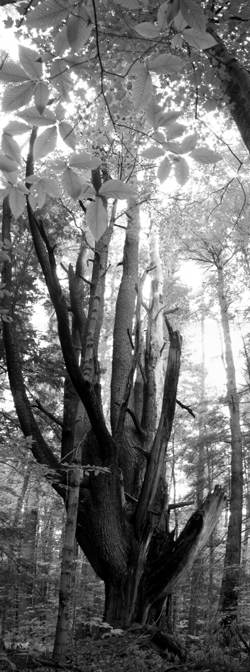
The Colonial Pine was named in 1787 for its 13 main branches, representing the 13 original American colonies.
Most cities and towns used American elms for their central greens and street trees because of their long straight trunks that widened to leafy canopies on top. Colebrook was typical of these towns. A map of the Town Center drawn by Adeline Wheeler in 1931 shows more than a dozen elms along with several sugar maples. The popularity of the American elm and its relative density led to the quick spread of the “Dutch” elm disease in the early 1930s and the death of most elms. While some of the maples remain, the last surviving American elm in the Center, which was on Schoolhouse Road, was taken down in July 2007. There are at least two young American elms being nurtured in Colebrook, one in the southwest section of town, the other in Robertsville.
Few trees were as versatile historically as the American chestnut, whose nuts provided food for humans and animals, whose wood was used in construction, and whose bark was used in tanning leather. While chestnuts were a dominant tree in most of the Eastern forest, this was not the case in early Colebrook, according to a 1760 survey. Other early records also tell of going to Sandisfield or Tolland to purchase chestnut shingles and fence posts, although there were several shingle mills right here in Colebrook that produced mostly white pine shingles.
Sadly, the American chestnut was virtually eradicated by a blight in the early decades of the 20th century. Although you can find sprouts from old trees, they all seem to succumb to disease before they become significant. There is a good example of an Asian-American chestnut on Eno Hill.

The American Chestnut is all but gone from our landscape, but this healthy Asian-American Chestnut stands atop Eno Hill.
An oak in front of the Colebrook Historical Society has grown from a second-generation acorn of the famed Charter Oak in Hartford.
In the Hale forest are sugar maples and white birch that are of great age. A black walnut on Phelps Road is reputed to be the oldest such tree in Colebrook and boasts a circumference of 9 feet 10 inches, a branch spread of 85 feet and an estimated height of 70 feet.
Large Trees
Colebrook abounds in large trees. Here are outstanding ones we heard about:
- A sugar maple diagonally across from the Rock School on Route183 has a circumference of 15 feet 10 inches, a branch spread of 54 feet and an estimated height of 55 feet.
- A white pine on Sandy Brook Road, just east of the Town Garage, has a 12-foot 2-inch circumference, a limb spread of 58 feet and stands 135 feet tall.
- On Moses Road is a smooth bark hickory with a circumference of 4 feet 6½ inches, a branch spread of 32 feet and an estimated height of 70 feet.
- A horse chestnut on Chapin Road that was planted in 1937.
- A black tupelo growing on the north side of the Sphagnum Swamp in the Algonquin State Forest has a circumference of six feet 3¼ inches, an estimated branch spread of 30-35 feet and an estimated height of 55 feet.
- Off of Deer Hill Road is a tulip-tree with a circumference of 9 feet 7 inches and a grove of tulip-trees whose circumferences all exceed 8½ feet.
- Two ash trees on Millbrook Road have circumferences of 16 feet 4 inches and 15 feet 7 inches.
- Near Rockwell Road is a remarkable striped maple with a circumference of 24 inches, a height of 35 feet and a limb spread of 20 feet.
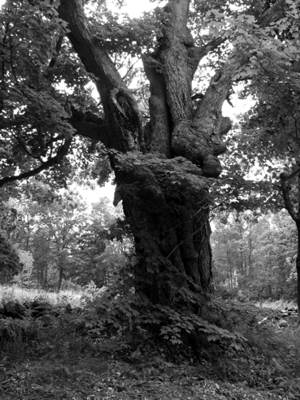
This large Sugar Maple is diagonally across from the Rock School on Route 183.
During the course of this survey, one landowner discovered eight state notable trees on their property. A Fraser fir is the largest in the state and a Chinese hemlock is tied for #1. There is also a Hinoki cypress ranked # 2; a black cherry and a Japanese umbrella pine both are the 6th largest in Connecticut; a Japanese white pine is #7; a weeping hemlock is #9; and a weeping beech comes in at #26. To have one state notable tree is impressive, to have eight is fantastic.
84 Varieties
A 1760 survey noted 19 varieties of trees in Colebrook. In our 2006 survey, 84 different types were identified. We have trees that provide food: apple, black cherry, black walnut, butternut, crabapple, pear, hickory and pecan. In our woodlands we can find ash, beech, various birches, oaks, hemlocks, ironwood, maples, pines, poplars, black tupelo, spruce and cedars. Along our roadsides we see locusts, catalpas, birches, sassafras, horse chestnuts, sycamore, tamarack, and willow. Our native species are enriched with exotics such as: dawn redwood, dogwoods, Fraser fir, Hinoki cypress, Japanese umbrella pine, Japanese white pine, Swiss stone pine, weeping beech, and weeping Japanese cherry.
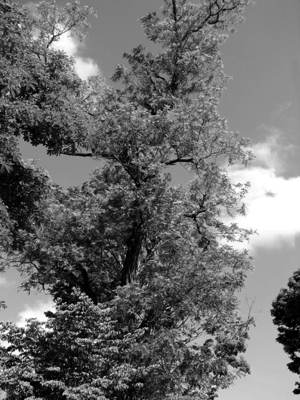
This Black Locust in the Town Center is one of 83 different native and non-native trees identified in our 2006 Colebrook survey.
The American elm and American chestnut, once so numerous, are all but gone in Colebrook. At present, several other species of trees are also in jeopardy. The wooly adelgid threatens the survival of our hemlocks. Maples, beeches, ashes and birches also are facing an uncertain future. It is important that we work to assure the health and diversity of our woodlands.
Then
- Beech (45%)
- Hemlock (25%)
- Maple & Hard Maple (11%)
- Birch: black, yellow, grey, white (8%)
- Ash: Black, Red, White (3%)
- Alder (2%)
- Witch Hazel (2%)
- Chestnut (1%)
- Basswood (American linden) (1%)
- Elm (0.5%)
- Butternut (0.5%)
- Red Oak (0.5%)
- White Oak (0.5%)
Now
- Apple (Pyrus malus)
- Arbor Vitae (Northern white cedar) (Thuja occidentalis)
- Ash (Fraxinus americana)
- Basswood: American linden (Tilia americana), European linden (Tilia europaea), white (Tilia heteruphylla)
- Beech: American beech (Fagus grandifolia), *weeping (Fagus pendula), *copper (Fagus sylvatixa v. purpurea)
- Birch: black (Betula lenta), yellow (Betula alleghaniensis), gray (Betula populifolia),white (Betula papyrifera), river (Betula nigra)
- Black alder (winterberry) (Ilex verticillata)
- Butternut (Juglans cinerea)
- Cedar: white (Chamaecyparis thyoides)
- Cherry: black (Prunus serotina), *weeping (Prunus pendula), choke cherry (Prunus virginiana)
- Chestnut: American (Castanea dentata), Asian-American (Castanea hybrid)
- Crab apple: (Pyrus x prunifolia), *flowering (Malus coronaria)
- *Dawn redwood (Metasequoia glyptosrobiodes)
- Dogwood: flowering (Cornus florida), *Chinese (Cornus kousa), *alternate leaved ( Cornus alternafolia)
- Elm: American (white) (Ulmus americana), slippery (red) (Ulmus rubra)
- *Fraser fir (Abies fraseri)
- Hemlock: (Tsuga canadensis), *weeping (Tsuga pendula), *Chinese (Tsuga chinensis)
- Hickory: shagbark (Carya ovata), smooth bark (pig nut) (Carya glabra)
- Honeylocust (Gleditsia tricanthos )
- *Hinoki cypress (Chamaecyparis obtuse)
- Horse chestnut (buckeye) (Aesculus hippocastanum)
- Hornbeam (blue beech) (Carpinus caroliniana)
- Ironwood (hop hornbeam) (Ostrya virginiana)
- Linden (Tilia europaea)
- Locust: black (Robinia pseudo-acacia)
- *Japanese umbrella pine (Sciadopitys verticillata)
- *Japanese white pine (Pinus parvaflora)
- Juniper: common (Juniperus communis), red cedar (Juniperus virginiana)
- *Magnolia (Magnolia acuminate L.)
- Maple: sugar (rock) (Acer saccharum), red (Acer rubrum), Norway (Acer platanoides), mountain (Acer spicatum), striped (Acer pensylvanicum), silver (Acer saccharinum)
- Mountain-ash (rowan) (Sorbus sp.)
- Northern catalpa (Catalpa bignonioides)
- Oak: red (Quercus rubra), white (Quercus alba), chestnut (Quercus prinus), black (Quercus velutina), pin (Quercus palustris)
- *Peach (Prunus persica)
- Pear (Pyrus communis)
- *Pecan (Carya illinoensis)
- Pine: white (Pinus strobus), red (Pinus resinosa), pitch (Pinus rigida)
- Poplar: quaking aspen (Populus tremuloides), cottonwood (Populus deltoides), large- toothed (Populus grandidentata)
- *Quince (Cydonia oblonga)
- Sassafras (Sassafras albidum)
- Spruce: black (Picea mariana), *Norway (Picea abies)
- Sumac: staghorn (red) (Rhus typhina)
- *Swiss stone pine (Pinus cembra)
- Sycamore (buttonball) (Platanus occidentalis)
- Tamarack (American larch) (Larix laricina)
- Tulip-tree (Liriodendron tulipifera)
- Tupelo: black (Nyssa sylvatica)
- Walnut: black (Juglans nigra)
- Willow: black ( Salix nigra), weeping (Salix babylonica), white (Salix alba)
- Witch hazel (Hamamelis virginiana)
* Indicates a tree not native to the area
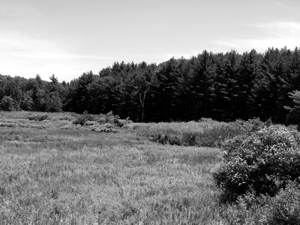
Beyond Phelps meadow on the east side of Route 183 are stands of White Pine.
Enjoy the Special Views, Vistas and
Groves of Trees in Colebrook
- The row of large hemlocks across Sandy Brook.
- If you can find your way to “Happy’s Pines” in the Kitchel Wilderness, it will be well worth the trek.
- The full canopy of trees on roads without power lines or where trees provide a canopy atop power lines: the top of Deer Hill Road, Rockwell Road from the Center to the Lily Pond, Bunnell Street from Phelps Road north about two-tenths of a mile, parts of Sandy Brook Road, Phelps Flat Road, Pisgah Mountain Road, Beech Hill Road from Sandy Brook Road to the next bridge, Beech Hill Road down from Chapin Road to Route 8, and Church Hill Road.
- The row of spruce trees on Colebrook River Road (Route 8) in Robertsville.
- The show of trees lining Sandy Brook and Still River as seen from the bridges in Robertsville.
- The spectacular oak trees along Gaylord Road.
- The row of Japanese dogwood trees just west of the intersection of Smith Hill and Deer Hill roads.
- The Japanese maple at the intersection of Smith Hill and Deer Hill roads.
- The white willow at the corner of Smith Hill and Bricklemaier roads.
- Look north across the first vista on Smith Hill Road up from Deer Hill Road and see the two very tall white pines on the ridge.
- Sugar maples on the west side of Old Colebrook Road and along Smith Hill Road.
- Sugar maples in the fields on the east side of Smith Hill Road.
- The two spruce trees on the east side of the Colebrook Church and the one beside the Colebrook Store.
- The flowering crabapples on the road to the recreation area.
- On Center Brook Road are fine old sugar maples and while you’re there, take a look over at Center Brook where you can see a lone larch on the island.
- Along Rockwell Road is an unobstructed stretch of mature mixed deciduous and coniferous forest featuring a variety of birch trees.
- Walk along the Hale Trail and you’ll see remarkable hemlock and pine.
- Weeping willows south of Phelps Road from the bridge just east of Pine Road.
- Oaks on the east side of Bunnell Street near Shantry Road.
- Two stands of white pine across Phelps meadow on the east side of Route 183.
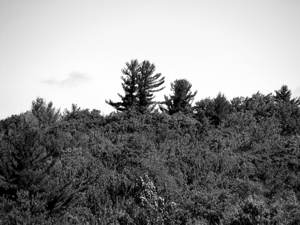
From Smith Hill Road you can see these large trees on the ridge. They survived lumbering because they didn’t contain straight boles and would yield small amounts of usable timber compared to the effort required to harvest them, thus earning the name “wolf trees.”
Where we go from Here:
In addition to chronicling our notable trees, the Colebrook Land Conservancy hopes this survey serves as a basis for a tree maintenance and replacement program. We need to watch our trees, particularly those under threat, such as hemlocks, beeches, maples, ashes and birches, and be ready to intervene if they show signs of insect infestation or disease. The trees on town property should be regularly examined and provided with optimal conditions for health and growth. It’s an effort requiring the cooperation of the people of Colebrook, but aren’t our trees worth it?
For their help in developing this report, special thanks to Colebrook Land Conservancy Trustees Leelaine Picker and Robert Grigg, who is also Town Historian.
© The Colebrook Land Conservancy, Inc. 2007
The Colebrook Land Conservancy
Post Office Box 90
Colebrook, Connecticut 06021
info@colebrooklandconservancy.org

Our Mission
Preserve and conserve the special and unique characteristics of Colebrook—rural, historic and scenic—using accepted land conservation techniques and education in cooperation with the Town, the community and other groups.
